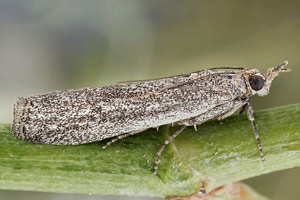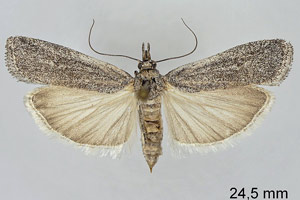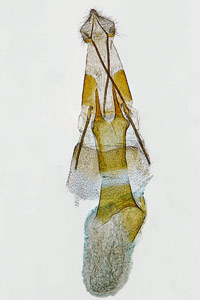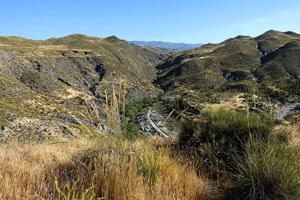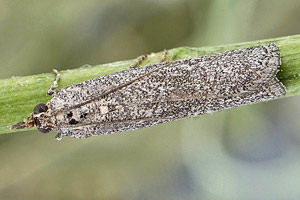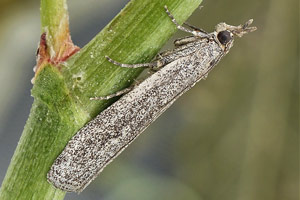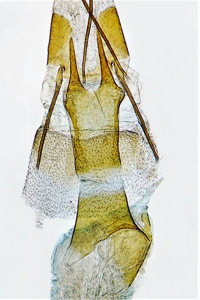1. Lebendfotos
1.1. Falter
1.2. Diagnose
1.2.1. Weibchen
1.3. Genitalien
1.3.1. Weibchen
2. Biologie
2.1. Habitat
2.2. Nahrung der Raupe
Noch unbekannt! Slamka et al. (2018) geben aber einen Hinweis: "The early stages and the larval foodplant are unknown; P. albipunctella is listed on Limonium pruinosum (L.) Chaz. (Plumbaginaceae) (Chrétien, 1911). P. iberica, is probably associated with many of the species that inhabit the same xerothermophilic habitat and is thought to be strongly stenochorous." Die Meldung zu Limonium pruinosum beruht allerdings nicht auf Raupenfunden, sondern lediglich dem Fund von 3 Kokons am Fuß der genannten Pflanze.
3. Weitere Informationen
3.1. Etymologie (Namenserklärung)
Slamka et al. (2018) erläutern: "Etymology: The species name iberica, (from Iberia), refers to the territory of the distribution of the new species."
3.2. Synonyme
- Laristania albipunctella sensu Leraut (2014) pro parte, nec (Chrétien, 1911)
3.3. Taxonomie und Faunistik
Nach Leraut (2014) gehört Selagia albipunctella Chrétien, 1911 in die Gattung Laristania. Slamka et al. (2018) widersprechen und stellen für die Art eine neue Gattung Pseudoinsalebria Slamka, Ylla & Macià, 2018, auf. Außerdem kommen sie zum Schluss, dass die südostspanischen Tiere nicht - wie von Leraut (2014) konstatiert - zur nordafrikanischen Laristania albipunctella bzw. Pseudoinsalebria albipunctella gehören, sondern zu einer zwar nahe verwandten, aber doch eigenständigen, zuvor noch unbeschriebenen Art: Pseudoinsalebria iberica Slamka, Ylla & Macià, 2018. Dies hat zur Folge, dass Pseudoinsalebria albipunctella wieder zu einer rein nordafrikanisch verbreiteten, in Europa fehlenden Art wird: "Specimens listed from Spain (Leraut, 2014; Palm, 2012; Vives Moreno, 2014; Ylla et al., 2008) belong to the new species P. iberica".
Alle bisher bekannten Vorkommen betreffen wüstenartige Bereiche in den Provinzen Murcia und - vor allem - Almería.
3.4. Typenmaterial
Slamka et al. (2018) schreiben zum Holotypus: "Holotype ♂, SPAIN: ALMERÍA, Tabernas, 425 m, 30S WF59, J. Ylla leg., 21-IV-2001, N-2001-06, gen. prep. nr. 1632 1 F. Slamka. Deposited in the MNCN, Madrid, Spain." Auch die 23 Paratypen stammen überwiegend aus der Provinz Almería, teilweise auch der Nachbarprovinz Murcia: "The holotype is deposited in the MNCN. The paratypes in coll. ZMUC, coll. NMPC, coll MCNB, coll. J. Ylla and coll. F. Slamka. The genitalia of holotype and the paratypes were permanently mounted in Euparal or Entellan, while others were stored in Glycerine in plastic tubes."
(Autor: Erwin Rennwald [Stand 29. Januar 2019])
3.5. Literatur
- Chrétien, P. (1911): Contribution à la connaissance des lépidoptères du nord de l'Afrique. — Annales de la Société entomologique de France 79 (4): 497-531. Paris.
- Leraut, P. (2014): Moths of Europe. Volume 4. Pyralids 2. - 441 S.; Verrières-le-Buisson (N.A.P Editions).
- Erstbeschreibung: Slamka, F., Ylla, J. & R. Macià (2018): Description of Pseudoinsalebria Slamka, Ylla & Macià, gen. n. and Pseudoinsalebria iberica Slamka, Ylla & Macià, sp. n., a closely related species to Pseudoinsalebria albipunctella (Chrétien, 1911) (Lepidoptera: Pyralidae, Phycitinae). — SHILAP Revista de lepidopterología 46 (184): 673-679. [PDF auf redalyc.org]




![Vorkommen in Spanien (Festland) [Slamka, F., Ylla, J. & R. Macià (2018)]](/res/img/flag/es.gif)
